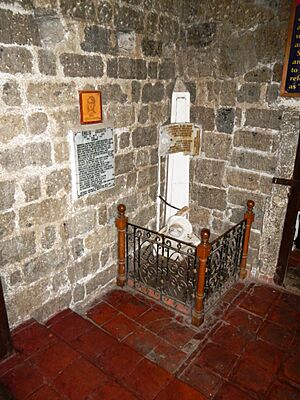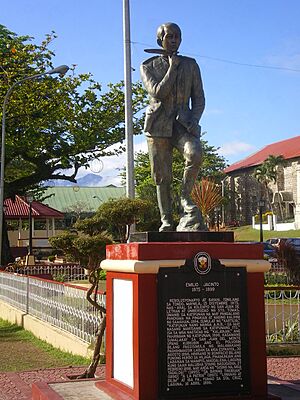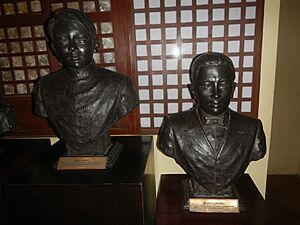Emilio Jacinto facts for kids
Quick facts for kids
Emilio Jacinto
|
|
|---|---|
 |
|
| Born |
Emilio Jacinto y Dizon
December 15, 1875 |
| Died | April 16, 1899 (aged 23) Santa Cruz, Laguna, First Philippine Republic
|
| Resting place | Himlayang Pilipino, Tandang Sora, Quezon City, Philippines |
| Other names | "Pingkian", "Dimasilaw", "Ka Ilyong" |
| Alma mater | Colegio de San Juan de Letran University of Santo Tomas |
| Spouse(s) | Catalina de Jesús |
Emilio Jacinto (born December 15, 1875 – died April 16, 1899) was an important Filipino general. He played a big role in the Philippine Revolution against Spanish rule.
Emilio Jacinto was one of the highest-ranking officers in the Katipunan. This was a secret group that fought for Philippine freedom. He was often called the Brains of the Katipunan. He was also present at the Cry of Pugad Lawin. This event signaled the start of the revolution.

Contents
Early Life and Education
Emilio Jacinto was born in Tondo, Manila. He was good at both Spanish and Tagalog languages. He first went to Colegio de San Juan de Letran. Later, he studied law at the University of Santo Tomas.
He did not finish his college studies. At 19 years old, he joined the secret society called the Katipunan.
Role in the Katipunan
Emilio Jacinto became a close friend and advisor to Andrés Bonifacio. Bonifacio was the leader of the Katipunan. Jacinto helped with money matters and served as a secretary. He was known as the Utak ng Katipunan, which means "Brain of the Katipunan".
Jacinto also wrote for the Katipunan's newspaper, Kalayaan. He used the pen name "Dimasilaw" for his writings. Inside the Katipunan, he used the alias "Pingkian". He also wrote the Kartilya ng Katipunan. This was a guidebook for all Katipunan members. It contained rules and principles for the group.
Later Life and Death
After Bonifacio passed away, Jacinto continued the fight for freedom. He did not join the forces of General Emilio Aguinaldo. Instead, he stayed in Laguna and fought against the Spanish.
Emilio Jacinto got sick with malaria. He died on April 16, 1899, in Santa Cruz, Laguna. He was married to Catalina de Jesús. She was expecting a child when he died. His remains were later moved to Himlayang Pilipino Memorial Park in Quezon City.
Important Writings
Emilio Jacinto wrote several important works for the Katipunan and the revolution.
- Katipunan nang Manga A. N. B. (around 1895): This was a guidebook for the Katipunan members. It taught them about honesty, honor, and fighting for freedom.
- "¡¡Gising Na Mga Tagalog!!" (1895): An essay that encouraged Filipinos to wake up and fight for their rights.
- Liwanag at Dilim (1896): A collection of essays. It talked about light and darkness, freedom, and equality.
- "A la patria" (1897): A poem dedicated to the homeland.
- "Sa Bayang Tinubuan" (undated): Another poem about his beloved country.
Tributes and Legacy
Emilio Jacinto is remembered as a hero in the Philippines.
- In the 1970s, his remains were moved to Himlayang Pilipino Memorial Park in Quezon City. There is a large bronze statue of him riding a horse.
- Another statue of Jacinto can be found in Mehan Garden.
- A new monument for Jacinto was put up in Magdalena, Laguna, in April 2017.
- His face used to be on the old 20 peso bill and the old 20 centavo coin.
Famous Quotes
Emilio Jacinto left behind many wise words. Here are some of his famous quotes:
- "Do not waste thy time: wealth can be recovered but not time lost."
- "The honorable man prefers honor to personal gain; the scoundrel, gain to honor."
- "To do good for personal gain and not for its own sake is not virtue."
- "Defend the oppressed and fight the oppressor before the law or in the field."
- "Whether our skin be black or white, we are all born equal: superiority in knowledge, wealth and beauty are to be understood, but not superiority by nature."




